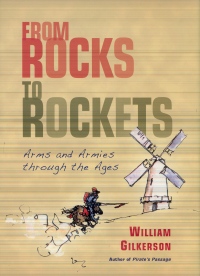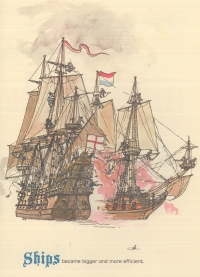| ________________
CM . . .
. Volume XV Number 10. . . .January 9, 2009 
 |
From Rocks to Rockets: Arms and Armies Through the Ages.
William Gilkerson.
Oxford, UK: Osprey (Distributed in Canada by Random House Canada), 1963/2008.
64 pp., hardcover, $15.95.
ISBN 978-1-84603-423-7.
Grades 4-7 / Ages 9-12.
Review by Val Ken Lem.
*1/2 /4
|
| |
|

excerpt:
Catapults were the first artillery. They were used to throw heavy stones and rocks, but the Greeks used them to propel great balls of fire.
Among the early Greeks were the Spartans, a people who were so much ahead of their time that they founded their whole culture on war.
Originally published in 1963 under the title Gilkerson on War: From Rocks to Rockets, this is a peculiar work that should have remained out of print. I expect the publisher may have been hoping to profit from Gilkerson's success as winner of the 2006 Governor General literary award for English-language children's text for his novel Pirate's Passage.
 As the subtitle suggests, this is a very brief overview of the history of warfare from prehistoric to modern times. The text is minimal, and much of the story is really to be found in Gilkerson's satirical cartoonish illustrations. For example, the passage about the catapult reproduced in the excerpt above is accompanied by three illustrations: the first shows a plumed-helmeted soldier lighting a flaming catapult, the second shows the entire catapult engulfed in flames, and the final depicts three deflated soldiers staring forlornly at their smouldering piece of ruined artillery. As the subtitle suggests, this is a very brief overview of the history of warfare from prehistoric to modern times. The text is minimal, and much of the story is really to be found in Gilkerson's satirical cartoonish illustrations. For example, the passage about the catapult reproduced in the excerpt above is accompanied by three illustrations: the first shows a plumed-helmeted soldier lighting a flaming catapult, the second shows the entire catapult engulfed in flames, and the final depicts three deflated soldiers staring forlornly at their smouldering piece of ruined artillery.
Gilkerson is a talented artist, and his illustrations are detailed and witty, but I think they will resonate better with adults who already have a grasp of military history. Pictorial references to Don Quixote and the famous windmill that appear at the beginning and end of the book will be lost on young readers.
The text, itself, is sparse yet laden with vocabulary that may be a challenge for young readers. Artillery, tactician and quartermaster may be understood based on the accompanying drawings, but little is done to identify the Goths and Huns who overran Rome. The text is Eurocentric, with an emphasis on the traditional Anglo-American focus on the rise of western civilization with its various historical periods: Greeks, Romans, Dark Ages, Middle Ages, Renaissance, and Revolutions (American and French) and modern era including the military use of aircraft. Gilkerson alludes to the atomic age and space age without mentioning the words atomic or nuclear and hasn't updated the text to be more inclusive of the fact that women now play more frontline roles in the western military nor to expand upon the militarization of space. References to gunpowder never mention its origins in China.
From Rocks to Rockets may have some use for reluctant readers who are fascinated with
war, although the illustrations and tone of the book are definitely designed to point to the futility of war rather than to glorify it. The text is too minimal to be of significant value as a source of information. Perhaps it could be used for visual literacy to encourage a youngster to examine the pictures and discuss the information that they convey about armies and military developments and the creator's intent.
Not recommended.
Val Ken Lem is the liaison librarian for history, English and Caribbean studies at Ryerson University in Toronto, ON.

To comment
on this title or this review, send mail to cm@umanitoba.ca.
Copyright © the Manitoba Library Association. Reproduction for personal
use is permitted only if this copyright notice is maintained. Any
other reproduction is prohibited without permission.
NEXT REVIEW |
TABLE OF CONTENTS FOR THIS ISSUE
- January 9, 2009.
AUTHORS |
TITLES |
MEDIA REVIEWS |
PROFILES |
BACK ISSUES |
SEARCH |
CMARCHIVE |
HOME |

 As the subtitle suggests, this is a very brief overview of the history of warfare from prehistoric to modern times. The text is minimal, and much of the story is really to be found in Gilkerson's satirical cartoonish illustrations. For example, the passage about the catapult reproduced in the excerpt above is accompanied by three illustrations: the first shows a plumed-helmeted soldier lighting a flaming catapult, the second shows the entire catapult engulfed in flames, and the final depicts three deflated soldiers staring forlornly at their smouldering piece of ruined artillery.
As the subtitle suggests, this is a very brief overview of the history of warfare from prehistoric to modern times. The text is minimal, and much of the story is really to be found in Gilkerson's satirical cartoonish illustrations. For example, the passage about the catapult reproduced in the excerpt above is accompanied by three illustrations: the first shows a plumed-helmeted soldier lighting a flaming catapult, the second shows the entire catapult engulfed in flames, and the final depicts three deflated soldiers staring forlornly at their smouldering piece of ruined artillery.